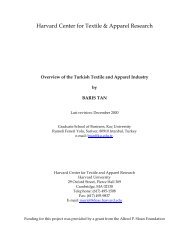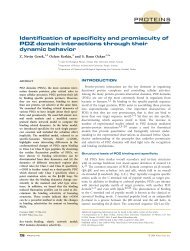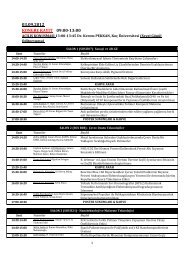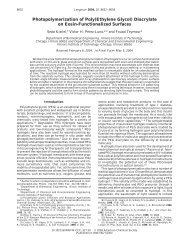RELATIVE INCOME HYPOTHESIS
RELATIVE INCOME HYPOTHESIS
RELATIVE INCOME HYPOTHESIS
Create successful ePaper yourself
Turn your PDF publications into a flip-book with our unique Google optimized e-Paper software.
ing factor between deprivation and rebellion as the expectation<br />
of success. “It is when the chains have been loosened<br />
somewhat, so that they can be cast off without a high<br />
probability of losing life, that people are put in a condition<br />
of rebelliousness” (Davies 1971, pp. 135–136).<br />
Subsequently theorists such as Doug McAdam and<br />
Sidney Tarrow have emphasized the mediating role of<br />
“political opportunity structures” in determining when<br />
relative deprivation and mobilization actually will lead to<br />
actions such as rebellions (McAdam, Tarrow, and Tilly<br />
2001). This work clearly echoes Tocqueville.<br />
For more than three decades Ted Robert Gurr integrated<br />
these and other emergent findings of the literature<br />
into his repeatedly revised and expanded general theory of<br />
ethnocultural rebellion and political action. His primary<br />
causal variable continues to be relative deprivation,<br />
although he defines it broadly like Davies as the difference<br />
between perceived entitlement and actual welfare, so that<br />
even relatively privileged groups may be motivated to<br />
rebel by perceived disadvantage. Gurr (2000) says three<br />
mediating variables determine whether deprivation actually<br />
will lead a group to take action—salience of ethnocultural<br />
identity, group capacity for mobilization (based<br />
partly on geography), and political opportunities for success.<br />
A domestic political variable—whether state institutions<br />
and resources favor repression or accommodation of<br />
group demands—determines whether ethnopolitical<br />
action will take the form of peaceful protest or violent<br />
rebellion. Prominent economists and political scientists,<br />
including Paul Collier, Anke Hoeffler, David Laitin, and<br />
Jim Fearon, have disputed the primary role of relative deprivation<br />
in motivating rebellion, which they say is driven<br />
less by grievance than by greed.<br />
SEE ALSO Aristotle; Coup d’Etat; Ethnic Conflict;<br />
Ethnocentrism; Marx, Karl; Poverty; Resistance;<br />
Revolution; Social Movements; Tocqueville, Alexis de;<br />
Wages<br />
BIBLIOGRAPHY<br />
Davies, James C., ed. 1971. When Men Revolt and Why: A<br />
Reader in Political Violence and Revolution. New York: Free<br />
Press.<br />
Gurr, Ted Robert. 2000. Peoples versus States. Washington, DC:<br />
U.S. Institute of Peace.<br />
Hoeffler, Anke, and Paul Collier. 2004. Greed and Grievance in<br />
Civil War. Oxford Economic Papers 56 (4): 563–595.<br />
McAdam, Doug, Sidney Tarrow, and Charles Tilly. 2001.<br />
Dynamics of Contention. New York: Cambridge University<br />
Press.<br />
Alan J. Kuperman<br />
Relative Income Hypothesis<br />
<strong>RELATIVE</strong> <strong>INCOME</strong><br />
<strong>HYPOTHESIS</strong><br />
Relative income hypothesis states that the satisfaction (or<br />
utility) an individual derives from a given consumption<br />
level depends on its relative magnitude in the society (e.g.,<br />
relative to the average consumption) rather than its<br />
absolute level. It is based on a postulate that has long been<br />
acknowledged by psychologists and sociologists, namely<br />
that individuals care about status. In economics, relative<br />
income hypothesis is attributed to James Duesenberry,<br />
who investigated the implications of this idea for consumption<br />
behavior in his 1949 book titled Income, Saving<br />
and the Theory of Consumer Behavior.<br />
At the time when Duesenberry wrote his book the<br />
dominant theory of consumption was the one developed<br />
by the English economist John Maynard Keynes, which<br />
was based on the hypothesis that individuals consume a<br />
decreasing, and save an increasing, percentage of their<br />
income as their income increases. This was indeed the pattern<br />
observed in cross-sectional consumption data: At a<br />
given point in time the rich in the population saved a<br />
higher fraction of their income than the poor did.<br />
However, Keynesian theory was contradicted by another<br />
empirical regularity: Aggregate saving rate did not grow<br />
over time as aggregate income grew. Duesenberry argued<br />
that relative income hypothesis could account for both the<br />
cross-sectional and time series evidence.<br />
Duesenberry claimed that an individual’s utility index<br />
depended on the ratio of his or her consumption to a<br />
weighted average of the consumption of the others. From<br />
this he drew two conclusions: (1) aggregate saving rate is<br />
independent of aggregate income, which is consistent<br />
with the time series evidence; and (2) the propensity to<br />
save of an individual is an increasing function of his or her<br />
percentile position in the income distribution, which is<br />
consistent with the cross-sectional evidence.<br />
Despite its intuitive and empirical appeal Duesenberry’s<br />
theory has not found wide acceptance and has been<br />
dominated by the life-cycle/permanent-income hypothesis<br />
of Franco Modigliani and Richard Brumberg (published<br />
in 1954) and Milton Friedman (1957). These<br />
closely related theories implied that consumption is an<br />
increasing function of the expected lifetime resources of<br />
an individual and could account for both the cross-sectional<br />
and time series evidence previously mentioned.<br />
However, starting with the 1970s, inability of these theories<br />
to explain some other puzzling empirical observations<br />
as well as the increasing evidence that people indeed seem<br />
to care about relative income have generated renewed<br />
interest in relative income hypothesis.<br />
The first piece of evidence was presented in 1974 by<br />
Richard Easterlin, who found that self-reported happiness<br />
of individuals (i.e., subjective well-being) varies directly<br />
INTERNATIONAL ENCYCLOPEDIA OF THE SOCIAL SCIENCES, 2ND EDITION 153
Relative Surplus Value<br />
with income at a given point in time but average wellbeing<br />
tends to be highly stable over time despite tremendous<br />
income growth. Easterlin argued that these patterns<br />
are consistent with the claim that an individual’s wellbeing<br />
depends mostly on relative income rather than<br />
absolute income. Subsequent research, such as that published<br />
by Andrew Oswald in 1997, has accumulated<br />
abundant evidence in support of this claim.<br />
Relative income hypothesis has also found some corroboration<br />
from indirect macroeconomic evidence. One<br />
of these is the observation that higher growth rates lead to<br />
higher saving rates, which is inconsistent with the lifecycle/permanent-income<br />
theory since the lifetime<br />
resources of an individual increases as growth rate<br />
increases. The work of Christopher Carroll, Jody<br />
Overland, and David N. Weil explains this observation<br />
with a growth model in which preferences depend negatively<br />
on the past consumption of the individual or on the<br />
past average consumption in the economy that is under<br />
the relative income hypothesis.<br />
Another empirical observation that has been problematic<br />
for the life-cycle/permanent-income theory is the equity<br />
premium puzzle, which states that the observed difference<br />
between the return on equity and the return on riskless assets<br />
is too large to be explained by a plausible specification of the<br />
theory. Introducing past average consumption into the preferences<br />
accounts for this observation much better.<br />
Relative income hypothesis has other important economic<br />
implications. Perhaps the most obvious implication<br />
is that consumption creates negative externalities in<br />
the society, which are not taken into account in individual<br />
decision-making. If individuals consume, and therefore<br />
work, to increase their status, then they will tend to work<br />
too much relative to the socially optimal level and hence<br />
income taxation could improve the social welfare.<br />
Relative income hypothesis is a special case of negatively<br />
interdependent preferences according to which individuals<br />
care about both their absolute and relative material<br />
payoffs. In 2000 Levent Koçkesen, Efe Ok, and Rajiv Sethi<br />
showed that negatively interdependent preferences yield a<br />
higher material payoff than do selfish preferences in many<br />
strategic environments, which implies that evolution will<br />
tend to favor the emergence of negatively interdependent<br />
preferences. This could be regarded as one explanation for<br />
the empirical support behind relative income hypothesis.<br />
SEE ALSO Absolute Income Hypothesis; Consumption;<br />
Life-Cycle Hypothesis; Microfoundations; Modigliani-<br />
Miller Theorems; Permanent Income Hypothesis<br />
BIBLIOGRAPHY<br />
Abel, Andrew B. 1990. Asset Prices under Habit Formation and<br />
Catching Up with the Joneses. American Economic Review 80<br />
(2): 38–42.<br />
Boskin, Michael J., and Eytan Sheshinski. 1978. Optimal<br />
Redistributive Taxation when Individual Welfare Depends<br />
upon Relative Income. Quarterly Journal of Economics 92 (4):<br />
589–601.<br />
Campbell, John Y., and John H. Cochrane. 1999. By Force of<br />
Habit: A Consumption-Based Explanation of Aggregate<br />
Stock Market Behavior. Journal of Political Economy 107 (2):<br />
205–251.<br />
Carroll, Christopher D., Jody Overland, and David N. Weil.<br />
1997. Comparison Utility in a Growth Model. Journal of<br />
Economic Growth 2 (4): 339–367.<br />
Carroll, Christopher D., Jody Overland, and David N. Weil.<br />
2000. Saving and Growth with Habit Formation. American<br />
Economic Review 90 (3): 341–355.<br />
Duesenberry, James S. 1949. Income, Saving and the Theory of<br />
Consumer Behavior. Cambridge, MA: Harvard University<br />
Press.<br />
Easterlin, Richard. 1974. Does Economic Growth Improve the<br />
Human Lot? Some Empirical Evidence. In Nations and<br />
Households in Economic Growth, ed. Paul A. David and<br />
Melvin W. Reder. New York: Academic Press.<br />
Friedman, Milton. 1957. A Theory of the Consumption Function.<br />
Princeton, NJ: Princeton University Press.<br />
Koçkesen, Levent, Efe A. Ok, and Rajiv Sethi. 2000. The<br />
Strategic Advantage of Negatively Interdependent<br />
Preferences. Journal of Economic Theory 92 (2): 274–299.<br />
Modigliani, Franco, and Richard Brumberg. 1954. Utility<br />
Analysis and the Consumption Function: An Interpretation<br />
of Cross-Section Data. In Post-Keynesian Economics, ed.<br />
Kenneth K. Kurihara. New Brunswick, NJ: Rutgers<br />
University Press.<br />
Oswald, Andrew J. 1997. Happiness and Economic<br />
Performance. Economic Journal 107 (November): 1815–1831.<br />
Levent Koçkesen<br />
<strong>RELATIVE</strong> SURPLUS<br />
VALUE<br />
Relative surplus value is a concept introduced by Karl<br />
Marx in chapter 12 of the first volume of his book Capital<br />
(1867). One of the key objectives of this book was to<br />
explain the origins of capitalist profit. Marx argued that<br />
profits could not arise simply from trading between commodity<br />
owners because such trade was what von<br />
Neumann (1944) would later call a zero sum game.<br />
Instead, the source of profit had to be sought outside the<br />
sphere of circulation in the process of capitalist production.<br />
Here, labor power that had been purchased by the<br />
capitalist was set to work to make things. The amount of<br />
value created by the laborers would be proportional to the<br />
number of hours worked whereas the sum advanced by<br />
the capitalist to purchase labor power would be proportional<br />
to the value of that labor power itself as a commod-<br />
154 INTERNATIONAL ENCYCLOPEDIA OF THE SOCIAL SCIENCES, 2ND EDITION


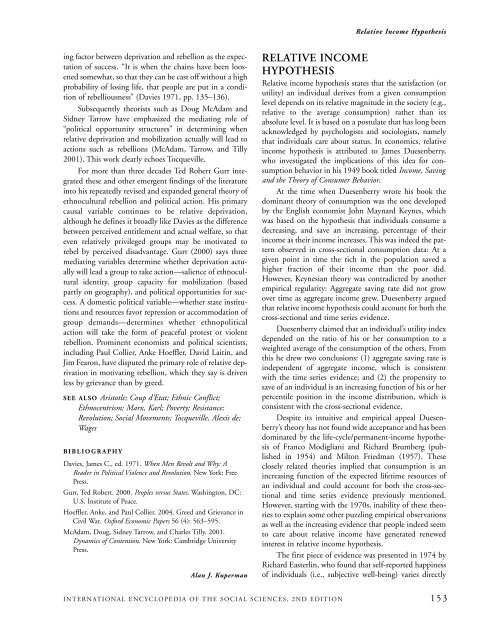
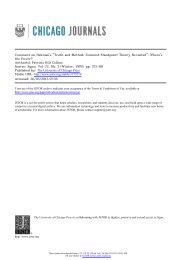
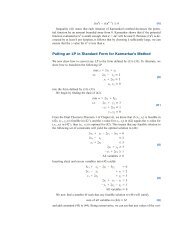

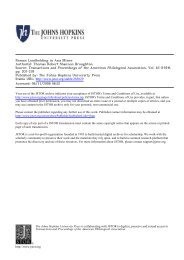
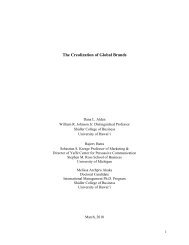

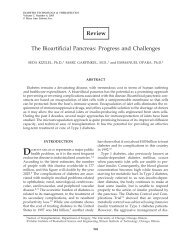
![]_[O](https://img.yumpu.com/10363126/1/190x138/-o.jpg?quality=85)
